University of Salford Nursing Case Study: Diabetes Management and Care
VerifiedAdded on 2022/10/17
|13
|3773
|29
Case Study
AI Summary
This case study focuses on a 27-year-old patient, Paul, diagnosed with Type 1 diabetes. The case study details Paul's symptoms, diagnostic tests, and the pathophysiology of the disease. It highlights two key patient needs: learning insulin injection techniques and adopting proper nutrition and dietary habits. The assignment emphasizes the crucial role of nurses in patient education, intervention planning, and evaluation. Nursing interventions include educating Paul on safe injection practices, promoting dietary management, and monitoring blood sugar levels. The evaluation process involves assessing Paul's adherence to treatment plans and the effectiveness of the interventions. The case study underscores the importance of patient-centered care, continuous assessment, and the use of evidence-based practices to improve outcomes for individuals with Type 1 diabetes.
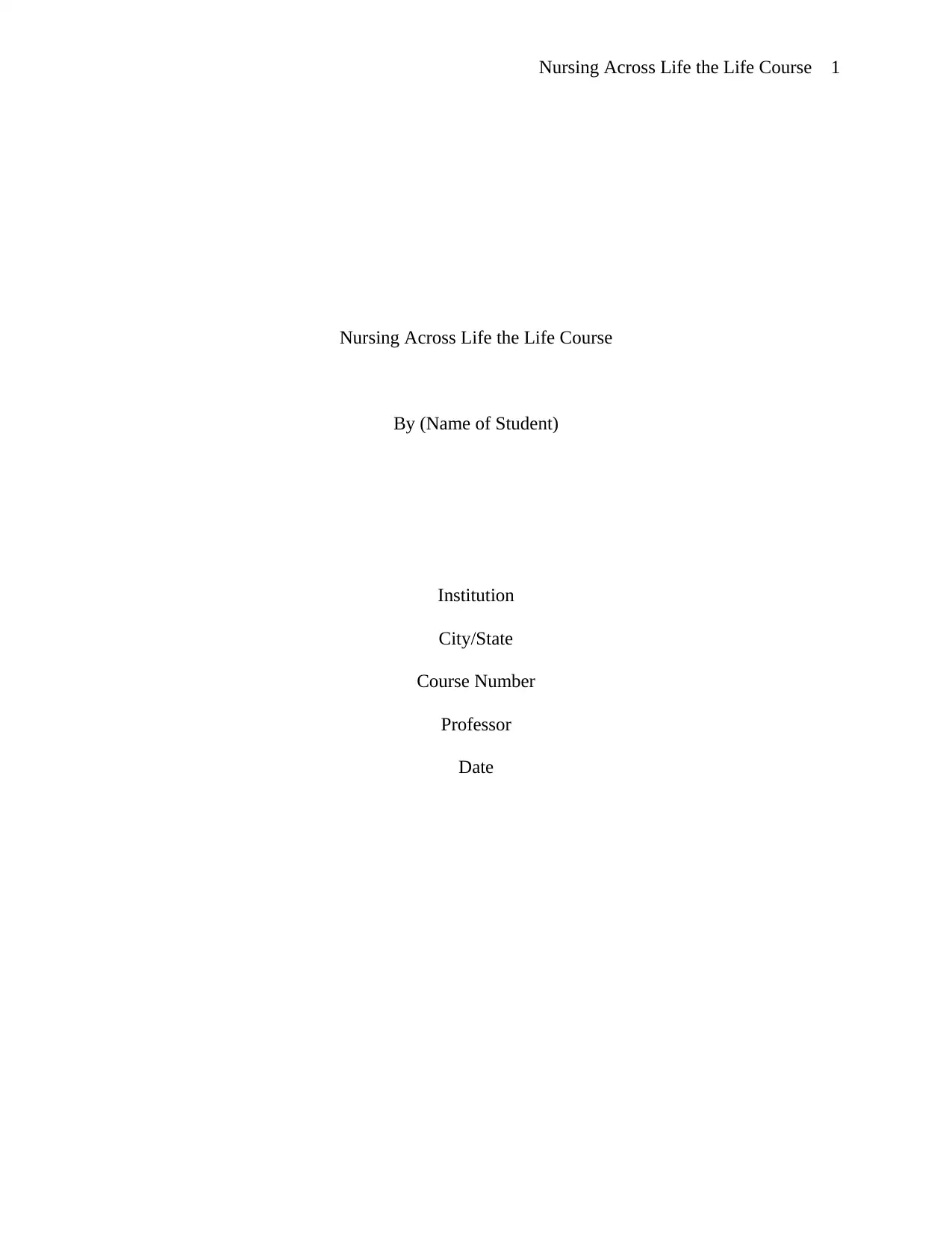
Nursing Across Life the Life Course 1
Nursing Across Life the Life Course
By (Name of Student)
Institution
City/State
Course Number
Professor
Date
Nursing Across Life the Life Course
By (Name of Student)
Institution
City/State
Course Number
Professor
Date
Paraphrase This Document
Need a fresh take? Get an instant paraphrase of this document with our AI Paraphraser
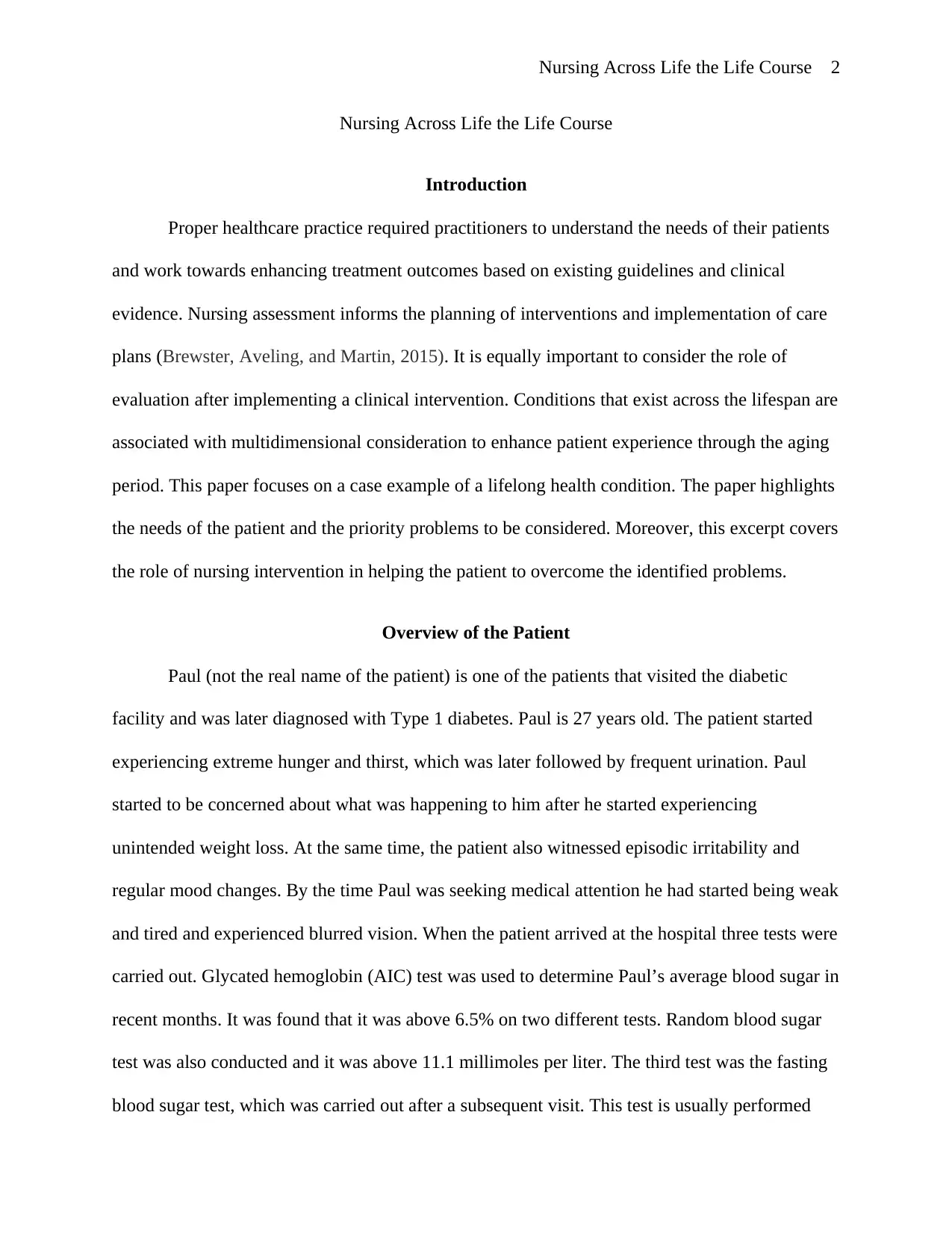
Nursing Across Life the Life Course 2
Nursing Across Life the Life Course
Introduction
Proper healthcare practice required practitioners to understand the needs of their patients
and work towards enhancing treatment outcomes based on existing guidelines and clinical
evidence. Nursing assessment informs the planning of interventions and implementation of care
plans (Brewster, Aveling, and Martin, 2015). It is equally important to consider the role of
evaluation after implementing a clinical intervention. Conditions that exist across the lifespan are
associated with multidimensional consideration to enhance patient experience through the aging
period. This paper focuses on a case example of a lifelong health condition. The paper highlights
the needs of the patient and the priority problems to be considered. Moreover, this excerpt covers
the role of nursing intervention in helping the patient to overcome the identified problems.
Overview of the Patient
Paul (not the real name of the patient) is one of the patients that visited the diabetic
facility and was later diagnosed with Type 1 diabetes. Paul is 27 years old. The patient started
experiencing extreme hunger and thirst, which was later followed by frequent urination. Paul
started to be concerned about what was happening to him after he started experiencing
unintended weight loss. At the same time, the patient also witnessed episodic irritability and
regular mood changes. By the time Paul was seeking medical attention he had started being weak
and tired and experienced blurred vision. When the patient arrived at the hospital three tests were
carried out. Glycated hemoglobin (AIC) test was used to determine Paul’s average blood sugar in
recent months. It was found that it was above 6.5% on two different tests. Random blood sugar
test was also conducted and it was above 11.1 millimoles per liter. The third test was the fasting
blood sugar test, which was carried out after a subsequent visit. This test is usually performed
Nursing Across Life the Life Course
Introduction
Proper healthcare practice required practitioners to understand the needs of their patients
and work towards enhancing treatment outcomes based on existing guidelines and clinical
evidence. Nursing assessment informs the planning of interventions and implementation of care
plans (Brewster, Aveling, and Martin, 2015). It is equally important to consider the role of
evaluation after implementing a clinical intervention. Conditions that exist across the lifespan are
associated with multidimensional consideration to enhance patient experience through the aging
period. This paper focuses on a case example of a lifelong health condition. The paper highlights
the needs of the patient and the priority problems to be considered. Moreover, this excerpt covers
the role of nursing intervention in helping the patient to overcome the identified problems.
Overview of the Patient
Paul (not the real name of the patient) is one of the patients that visited the diabetic
facility and was later diagnosed with Type 1 diabetes. Paul is 27 years old. The patient started
experiencing extreme hunger and thirst, which was later followed by frequent urination. Paul
started to be concerned about what was happening to him after he started experiencing
unintended weight loss. At the same time, the patient also witnessed episodic irritability and
regular mood changes. By the time Paul was seeking medical attention he had started being weak
and tired and experienced blurred vision. When the patient arrived at the hospital three tests were
carried out. Glycated hemoglobin (AIC) test was used to determine Paul’s average blood sugar in
recent months. It was found that it was above 6.5% on two different tests. Random blood sugar
test was also conducted and it was above 11.1 millimoles per liter. The third test was the fasting
blood sugar test, which was carried out after a subsequent visit. This test is usually performed
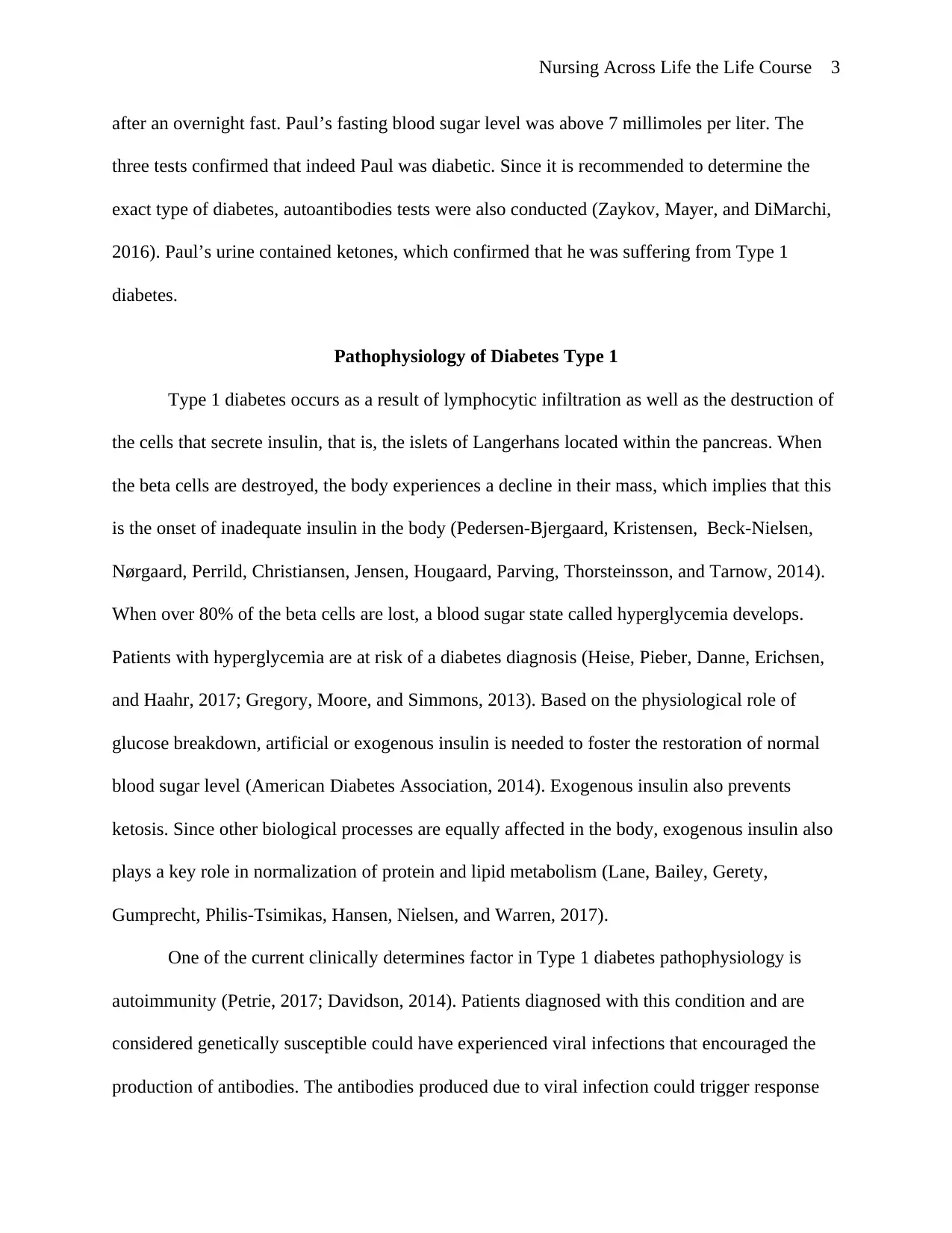
Nursing Across Life the Life Course 3
after an overnight fast. Paul’s fasting blood sugar level was above 7 millimoles per liter. The
three tests confirmed that indeed Paul was diabetic. Since it is recommended to determine the
exact type of diabetes, autoantibodies tests were also conducted (Zaykov, Mayer, and DiMarchi,
2016). Paul’s urine contained ketones, which confirmed that he was suffering from Type 1
diabetes.
Pathophysiology of Diabetes Type 1
Type 1 diabetes occurs as a result of lymphocytic infiltration as well as the destruction of
the cells that secrete insulin, that is, the islets of Langerhans located within the pancreas. When
the beta cells are destroyed, the body experiences a decline in their mass, which implies that this
is the onset of inadequate insulin in the body (Pedersen-Bjergaard, Kristensen, Beck-Nielsen,
Nørgaard, Perrild, Christiansen, Jensen, Hougaard, Parving, Thorsteinsson, and Tarnow, 2014).
When over 80% of the beta cells are lost, a blood sugar state called hyperglycemia develops.
Patients with hyperglycemia are at risk of a diabetes diagnosis (Heise, Pieber, Danne, Erichsen,
and Haahr, 2017; Gregory, Moore, and Simmons, 2013). Based on the physiological role of
glucose breakdown, artificial or exogenous insulin is needed to foster the restoration of normal
blood sugar level (American Diabetes Association, 2014). Exogenous insulin also prevents
ketosis. Since other biological processes are equally affected in the body, exogenous insulin also
plays a key role in normalization of protein and lipid metabolism (Lane, Bailey, Gerety,
Gumprecht, Philis-Tsimikas, Hansen, Nielsen, and Warren, 2017).
One of the current clinically determines factor in Type 1 diabetes pathophysiology is
autoimmunity (Petrie, 2017; Davidson, 2014). Patients diagnosed with this condition and are
considered genetically susceptible could have experienced viral infections that encouraged the
production of antibodies. The antibodies produced due to viral infection could trigger response
after an overnight fast. Paul’s fasting blood sugar level was above 7 millimoles per liter. The
three tests confirmed that indeed Paul was diabetic. Since it is recommended to determine the
exact type of diabetes, autoantibodies tests were also conducted (Zaykov, Mayer, and DiMarchi,
2016). Paul’s urine contained ketones, which confirmed that he was suffering from Type 1
diabetes.
Pathophysiology of Diabetes Type 1
Type 1 diabetes occurs as a result of lymphocytic infiltration as well as the destruction of
the cells that secrete insulin, that is, the islets of Langerhans located within the pancreas. When
the beta cells are destroyed, the body experiences a decline in their mass, which implies that this
is the onset of inadequate insulin in the body (Pedersen-Bjergaard, Kristensen, Beck-Nielsen,
Nørgaard, Perrild, Christiansen, Jensen, Hougaard, Parving, Thorsteinsson, and Tarnow, 2014).
When over 80% of the beta cells are lost, a blood sugar state called hyperglycemia develops.
Patients with hyperglycemia are at risk of a diabetes diagnosis (Heise, Pieber, Danne, Erichsen,
and Haahr, 2017; Gregory, Moore, and Simmons, 2013). Based on the physiological role of
glucose breakdown, artificial or exogenous insulin is needed to foster the restoration of normal
blood sugar level (American Diabetes Association, 2014). Exogenous insulin also prevents
ketosis. Since other biological processes are equally affected in the body, exogenous insulin also
plays a key role in normalization of protein and lipid metabolism (Lane, Bailey, Gerety,
Gumprecht, Philis-Tsimikas, Hansen, Nielsen, and Warren, 2017).
One of the current clinically determines factor in Type 1 diabetes pathophysiology is
autoimmunity (Petrie, 2017; Davidson, 2014). Patients diagnosed with this condition and are
considered genetically susceptible could have experienced viral infections that encouraged the
production of antibodies. The antibodies produced due to viral infection could trigger response
⊘ This is a preview!⊘
Do you want full access?
Subscribe today to unlock all pages.

Trusted by 1+ million students worldwide
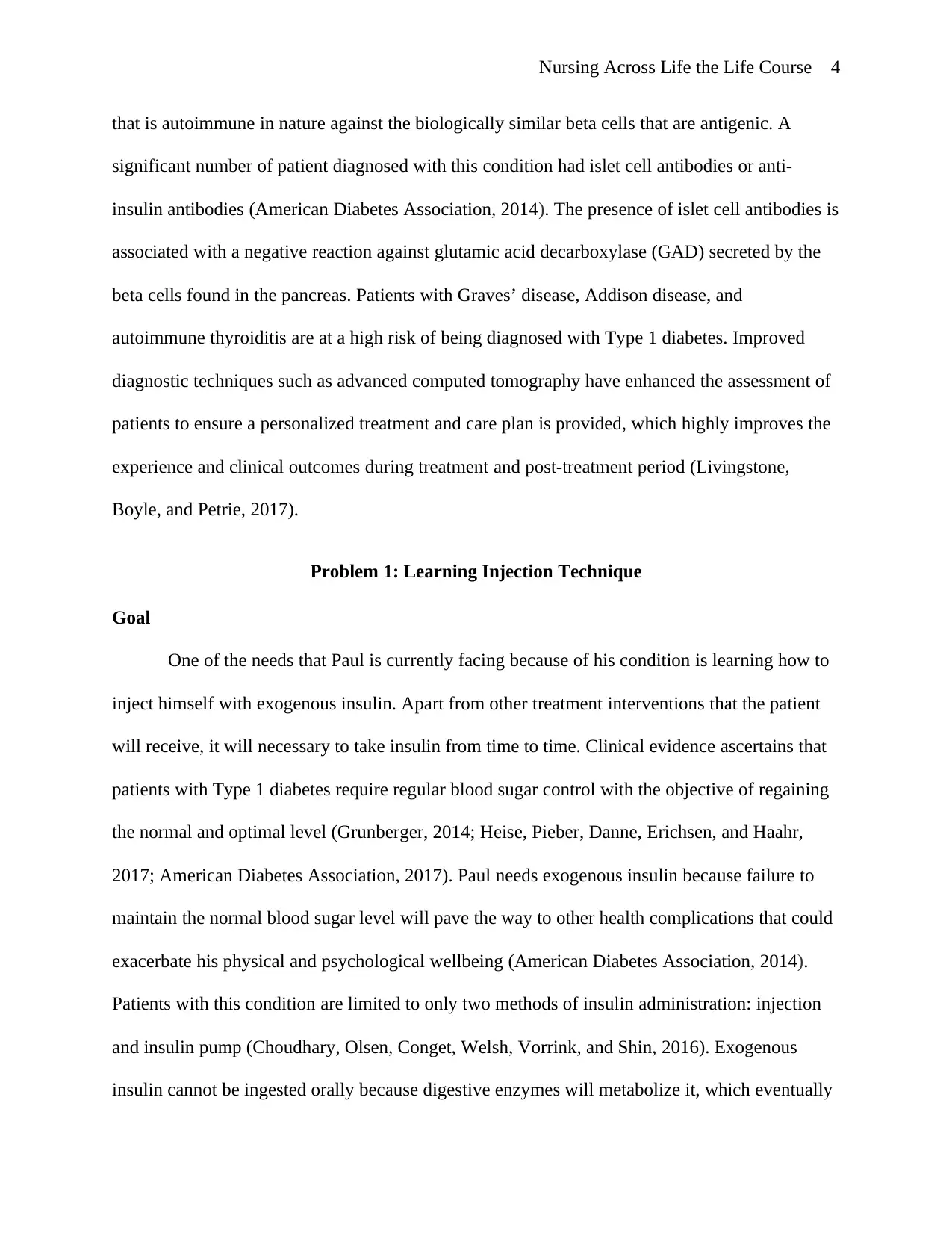
Nursing Across Life the Life Course 4
that is autoimmune in nature against the biologically similar beta cells that are antigenic. A
significant number of patient diagnosed with this condition had islet cell antibodies or anti-
insulin antibodies (American Diabetes Association, 2014). The presence of islet cell antibodies is
associated with a negative reaction against glutamic acid decarboxylase (GAD) secreted by the
beta cells found in the pancreas. Patients with Graves’ disease, Addison disease, and
autoimmune thyroiditis are at a high risk of being diagnosed with Type 1 diabetes. Improved
diagnostic techniques such as advanced computed tomography have enhanced the assessment of
patients to ensure a personalized treatment and care plan is provided, which highly improves the
experience and clinical outcomes during treatment and post-treatment period (Livingstone,
Boyle, and Petrie, 2017).
Problem 1: Learning Injection Technique
Goal
One of the needs that Paul is currently facing because of his condition is learning how to
inject himself with exogenous insulin. Apart from other treatment interventions that the patient
will receive, it will necessary to take insulin from time to time. Clinical evidence ascertains that
patients with Type 1 diabetes require regular blood sugar control with the objective of regaining
the normal and optimal level (Grunberger, 2014; Heise, Pieber, Danne, Erichsen, and Haahr,
2017; American Diabetes Association, 2017). Paul needs exogenous insulin because failure to
maintain the normal blood sugar level will pave the way to other health complications that could
exacerbate his physical and psychological wellbeing (American Diabetes Association, 2014).
Patients with this condition are limited to only two methods of insulin administration: injection
and insulin pump (Choudhary, Olsen, Conget, Welsh, Vorrink, and Shin, 2016). Exogenous
insulin cannot be ingested orally because digestive enzymes will metabolize it, which eventually
that is autoimmune in nature against the biologically similar beta cells that are antigenic. A
significant number of patient diagnosed with this condition had islet cell antibodies or anti-
insulin antibodies (American Diabetes Association, 2014). The presence of islet cell antibodies is
associated with a negative reaction against glutamic acid decarboxylase (GAD) secreted by the
beta cells found in the pancreas. Patients with Graves’ disease, Addison disease, and
autoimmune thyroiditis are at a high risk of being diagnosed with Type 1 diabetes. Improved
diagnostic techniques such as advanced computed tomography have enhanced the assessment of
patients to ensure a personalized treatment and care plan is provided, which highly improves the
experience and clinical outcomes during treatment and post-treatment period (Livingstone,
Boyle, and Petrie, 2017).
Problem 1: Learning Injection Technique
Goal
One of the needs that Paul is currently facing because of his condition is learning how to
inject himself with exogenous insulin. Apart from other treatment interventions that the patient
will receive, it will necessary to take insulin from time to time. Clinical evidence ascertains that
patients with Type 1 diabetes require regular blood sugar control with the objective of regaining
the normal and optimal level (Grunberger, 2014; Heise, Pieber, Danne, Erichsen, and Haahr,
2017; American Diabetes Association, 2017). Paul needs exogenous insulin because failure to
maintain the normal blood sugar level will pave the way to other health complications that could
exacerbate his physical and psychological wellbeing (American Diabetes Association, 2014).
Patients with this condition are limited to only two methods of insulin administration: injection
and insulin pump (Choudhary, Olsen, Conget, Welsh, Vorrink, and Shin, 2016). Exogenous
insulin cannot be ingested orally because digestive enzymes will metabolize it, which eventually
Paraphrase This Document
Need a fresh take? Get an instant paraphrase of this document with our AI Paraphraser
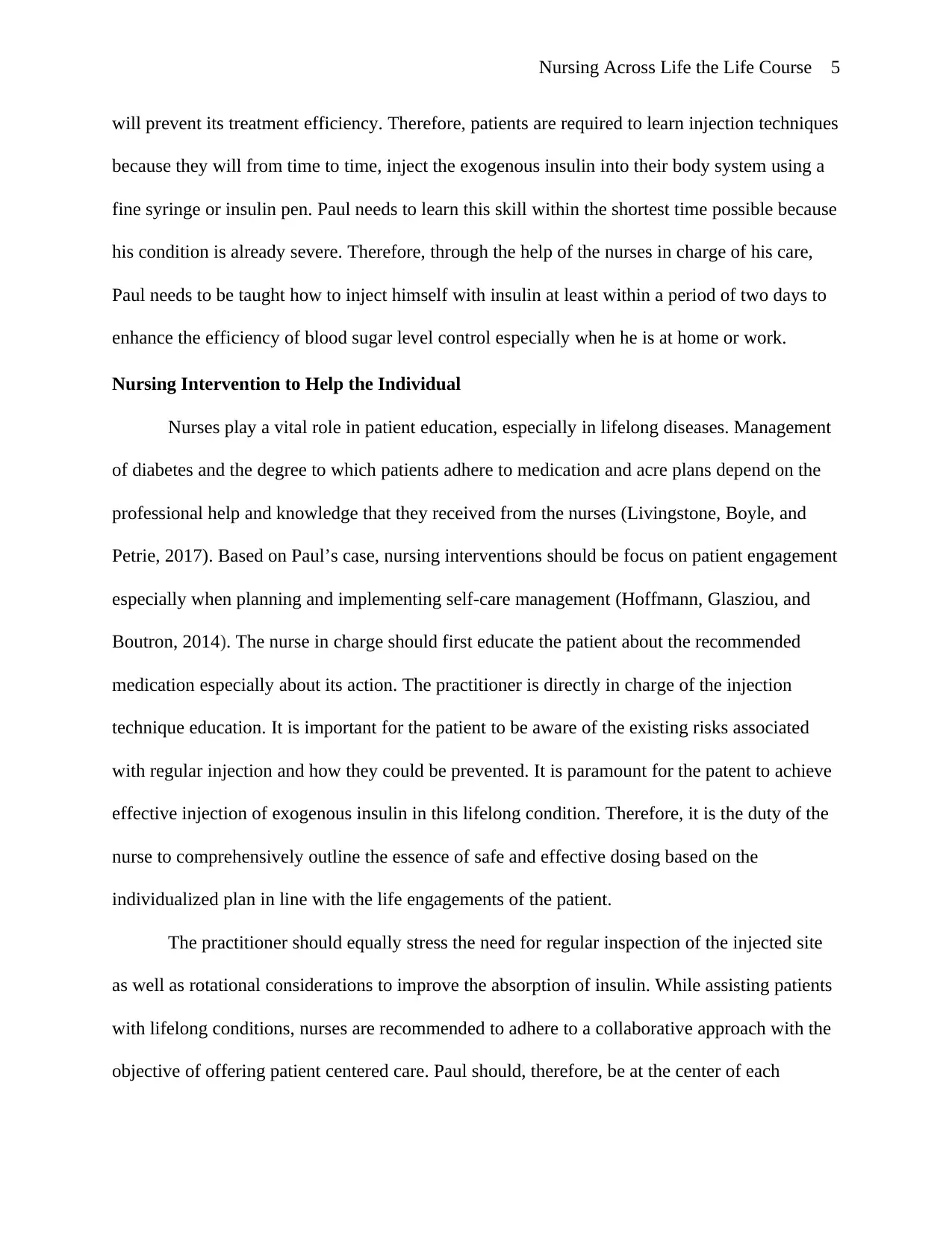
Nursing Across Life the Life Course 5
will prevent its treatment efficiency. Therefore, patients are required to learn injection techniques
because they will from time to time, inject the exogenous insulin into their body system using a
fine syringe or insulin pen. Paul needs to learn this skill within the shortest time possible because
his condition is already severe. Therefore, through the help of the nurses in charge of his care,
Paul needs to be taught how to inject himself with insulin at least within a period of two days to
enhance the efficiency of blood sugar level control especially when he is at home or work.
Nursing Intervention to Help the Individual
Nurses play a vital role in patient education, especially in lifelong diseases. Management
of diabetes and the degree to which patients adhere to medication and acre plans depend on the
professional help and knowledge that they received from the nurses (Livingstone, Boyle, and
Petrie, 2017). Based on Paul’s case, nursing interventions should be focus on patient engagement
especially when planning and implementing self-care management (Hoffmann, Glasziou, and
Boutron, 2014). The nurse in charge should first educate the patient about the recommended
medication especially about its action. The practitioner is directly in charge of the injection
technique education. It is important for the patient to be aware of the existing risks associated
with regular injection and how they could be prevented. It is paramount for the patent to achieve
effective injection of exogenous insulin in this lifelong condition. Therefore, it is the duty of the
nurse to comprehensively outline the essence of safe and effective dosing based on the
individualized plan in line with the life engagements of the patient.
The practitioner should equally stress the need for regular inspection of the injected site
as well as rotational considerations to improve the absorption of insulin. While assisting patients
with lifelong conditions, nurses are recommended to adhere to a collaborative approach with the
objective of offering patient centered care. Paul should, therefore, be at the center of each
will prevent its treatment efficiency. Therefore, patients are required to learn injection techniques
because they will from time to time, inject the exogenous insulin into their body system using a
fine syringe or insulin pen. Paul needs to learn this skill within the shortest time possible because
his condition is already severe. Therefore, through the help of the nurses in charge of his care,
Paul needs to be taught how to inject himself with insulin at least within a period of two days to
enhance the efficiency of blood sugar level control especially when he is at home or work.
Nursing Intervention to Help the Individual
Nurses play a vital role in patient education, especially in lifelong diseases. Management
of diabetes and the degree to which patients adhere to medication and acre plans depend on the
professional help and knowledge that they received from the nurses (Livingstone, Boyle, and
Petrie, 2017). Based on Paul’s case, nursing interventions should be focus on patient engagement
especially when planning and implementing self-care management (Hoffmann, Glasziou, and
Boutron, 2014). The nurse in charge should first educate the patient about the recommended
medication especially about its action. The practitioner is directly in charge of the injection
technique education. It is important for the patient to be aware of the existing risks associated
with regular injection and how they could be prevented. It is paramount for the patent to achieve
effective injection of exogenous insulin in this lifelong condition. Therefore, it is the duty of the
nurse to comprehensively outline the essence of safe and effective dosing based on the
individualized plan in line with the life engagements of the patient.
The practitioner should equally stress the need for regular inspection of the injected site
as well as rotational considerations to improve the absorption of insulin. While assisting patients
with lifelong conditions, nurses are recommended to adhere to a collaborative approach with the
objective of offering patient centered care. Paul should, therefore, be at the center of each
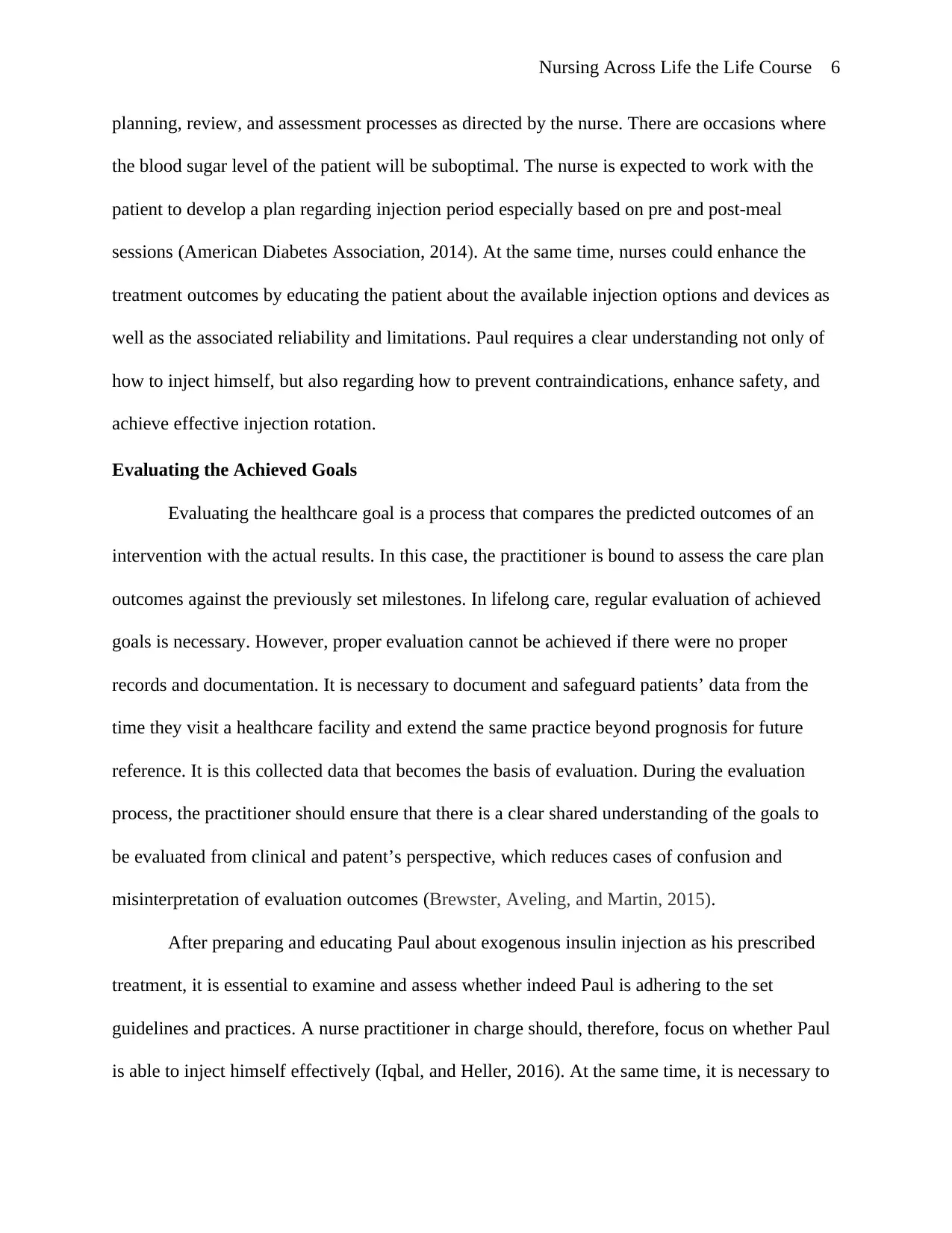
Nursing Across Life the Life Course 6
planning, review, and assessment processes as directed by the nurse. There are occasions where
the blood sugar level of the patient will be suboptimal. The nurse is expected to work with the
patient to develop a plan regarding injection period especially based on pre and post-meal
sessions (American Diabetes Association, 2014). At the same time, nurses could enhance the
treatment outcomes by educating the patient about the available injection options and devices as
well as the associated reliability and limitations. Paul requires a clear understanding not only of
how to inject himself, but also regarding how to prevent contraindications, enhance safety, and
achieve effective injection rotation.
Evaluating the Achieved Goals
Evaluating the healthcare goal is a process that compares the predicted outcomes of an
intervention with the actual results. In this case, the practitioner is bound to assess the care plan
outcomes against the previously set milestones. In lifelong care, regular evaluation of achieved
goals is necessary. However, proper evaluation cannot be achieved if there were no proper
records and documentation. It is necessary to document and safeguard patients’ data from the
time they visit a healthcare facility and extend the same practice beyond prognosis for future
reference. It is this collected data that becomes the basis of evaluation. During the evaluation
process, the practitioner should ensure that there is a clear shared understanding of the goals to
be evaluated from clinical and patent’s perspective, which reduces cases of confusion and
misinterpretation of evaluation outcomes (Brewster, Aveling, and Martin, 2015).
After preparing and educating Paul about exogenous insulin injection as his prescribed
treatment, it is essential to examine and assess whether indeed Paul is adhering to the set
guidelines and practices. A nurse practitioner in charge should, therefore, focus on whether Paul
is able to inject himself effectively (Iqbal, and Heller, 2016). At the same time, it is necessary to
planning, review, and assessment processes as directed by the nurse. There are occasions where
the blood sugar level of the patient will be suboptimal. The nurse is expected to work with the
patient to develop a plan regarding injection period especially based on pre and post-meal
sessions (American Diabetes Association, 2014). At the same time, nurses could enhance the
treatment outcomes by educating the patient about the available injection options and devices as
well as the associated reliability and limitations. Paul requires a clear understanding not only of
how to inject himself, but also regarding how to prevent contraindications, enhance safety, and
achieve effective injection rotation.
Evaluating the Achieved Goals
Evaluating the healthcare goal is a process that compares the predicted outcomes of an
intervention with the actual results. In this case, the practitioner is bound to assess the care plan
outcomes against the previously set milestones. In lifelong care, regular evaluation of achieved
goals is necessary. However, proper evaluation cannot be achieved if there were no proper
records and documentation. It is necessary to document and safeguard patients’ data from the
time they visit a healthcare facility and extend the same practice beyond prognosis for future
reference. It is this collected data that becomes the basis of evaluation. During the evaluation
process, the practitioner should ensure that there is a clear shared understanding of the goals to
be evaluated from clinical and patent’s perspective, which reduces cases of confusion and
misinterpretation of evaluation outcomes (Brewster, Aveling, and Martin, 2015).
After preparing and educating Paul about exogenous insulin injection as his prescribed
treatment, it is essential to examine and assess whether indeed Paul is adhering to the set
guidelines and practices. A nurse practitioner in charge should, therefore, focus on whether Paul
is able to inject himself effectively (Iqbal, and Heller, 2016). At the same time, it is necessary to
⊘ This is a preview!⊘
Do you want full access?
Subscribe today to unlock all pages.

Trusted by 1+ million students worldwide
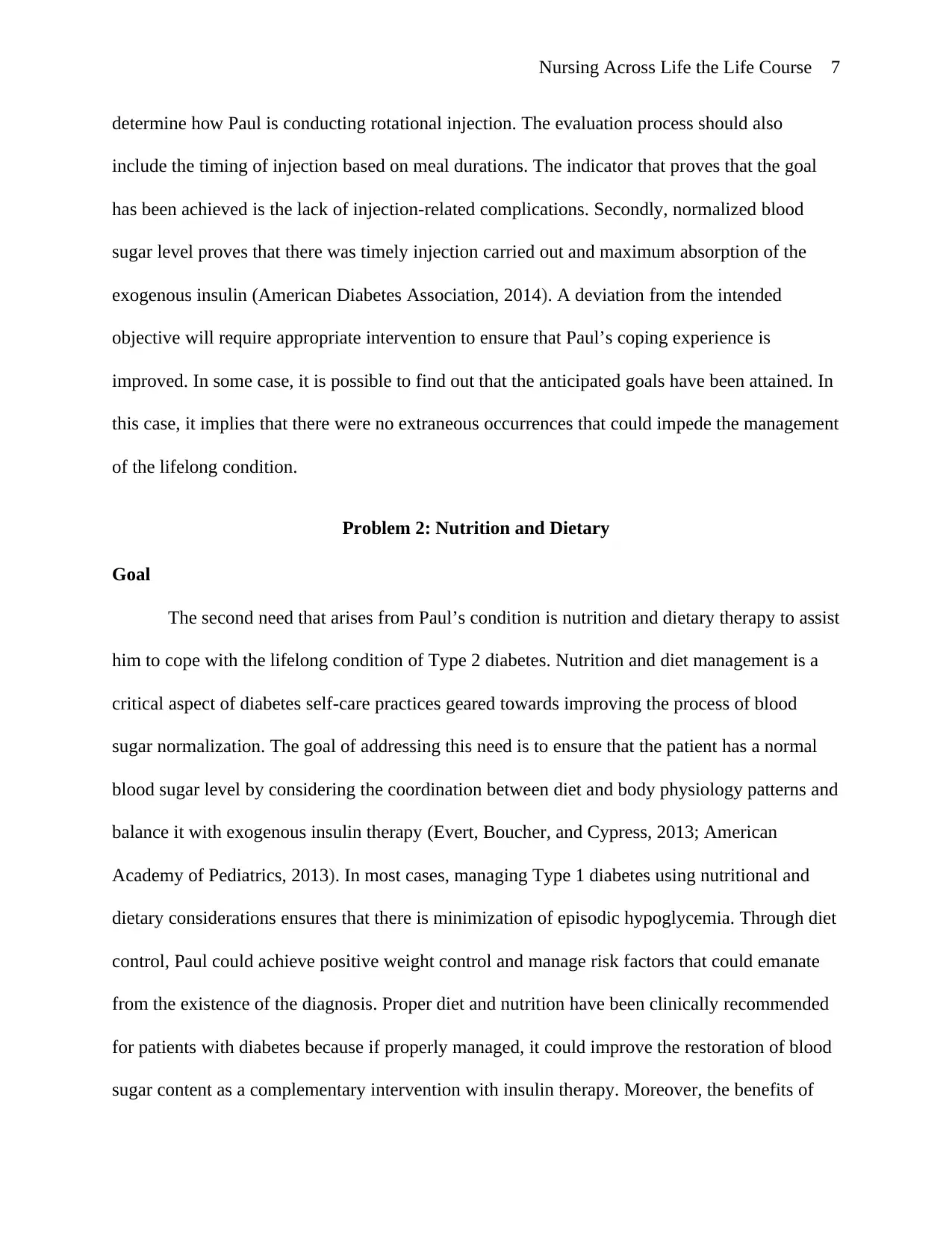
Nursing Across Life the Life Course 7
determine how Paul is conducting rotational injection. The evaluation process should also
include the timing of injection based on meal durations. The indicator that proves that the goal
has been achieved is the lack of injection-related complications. Secondly, normalized blood
sugar level proves that there was timely injection carried out and maximum absorption of the
exogenous insulin (American Diabetes Association, 2014). A deviation from the intended
objective will require appropriate intervention to ensure that Paul’s coping experience is
improved. In some case, it is possible to find out that the anticipated goals have been attained. In
this case, it implies that there were no extraneous occurrences that could impede the management
of the lifelong condition.
Problem 2: Nutrition and Dietary
Goal
The second need that arises from Paul’s condition is nutrition and dietary therapy to assist
him to cope with the lifelong condition of Type 2 diabetes. Nutrition and diet management is a
critical aspect of diabetes self-care practices geared towards improving the process of blood
sugar normalization. The goal of addressing this need is to ensure that the patient has a normal
blood sugar level by considering the coordination between diet and body physiology patterns and
balance it with exogenous insulin therapy (Evert, Boucher, and Cypress, 2013; American
Academy of Pediatrics, 2013). In most cases, managing Type 1 diabetes using nutritional and
dietary considerations ensures that there is minimization of episodic hypoglycemia. Through diet
control, Paul could achieve positive weight control and manage risk factors that could emanate
from the existence of the diagnosis. Proper diet and nutrition have been clinically recommended
for patients with diabetes because if properly managed, it could improve the restoration of blood
sugar content as a complementary intervention with insulin therapy. Moreover, the benefits of
determine how Paul is conducting rotational injection. The evaluation process should also
include the timing of injection based on meal durations. The indicator that proves that the goal
has been achieved is the lack of injection-related complications. Secondly, normalized blood
sugar level proves that there was timely injection carried out and maximum absorption of the
exogenous insulin (American Diabetes Association, 2014). A deviation from the intended
objective will require appropriate intervention to ensure that Paul’s coping experience is
improved. In some case, it is possible to find out that the anticipated goals have been attained. In
this case, it implies that there were no extraneous occurrences that could impede the management
of the lifelong condition.
Problem 2: Nutrition and Dietary
Goal
The second need that arises from Paul’s condition is nutrition and dietary therapy to assist
him to cope with the lifelong condition of Type 2 diabetes. Nutrition and diet management is a
critical aspect of diabetes self-care practices geared towards improving the process of blood
sugar normalization. The goal of addressing this need is to ensure that the patient has a normal
blood sugar level by considering the coordination between diet and body physiology patterns and
balance it with exogenous insulin therapy (Evert, Boucher, and Cypress, 2013; American
Academy of Pediatrics, 2013). In most cases, managing Type 1 diabetes using nutritional and
dietary considerations ensures that there is minimization of episodic hypoglycemia. Through diet
control, Paul could achieve positive weight control and manage risk factors that could emanate
from the existence of the diagnosis. Proper diet and nutrition have been clinically recommended
for patients with diabetes because if properly managed, it could improve the restoration of blood
sugar content as a complementary intervention with insulin therapy. Moreover, the benefits of
Paraphrase This Document
Need a fresh take? Get an instant paraphrase of this document with our AI Paraphraser
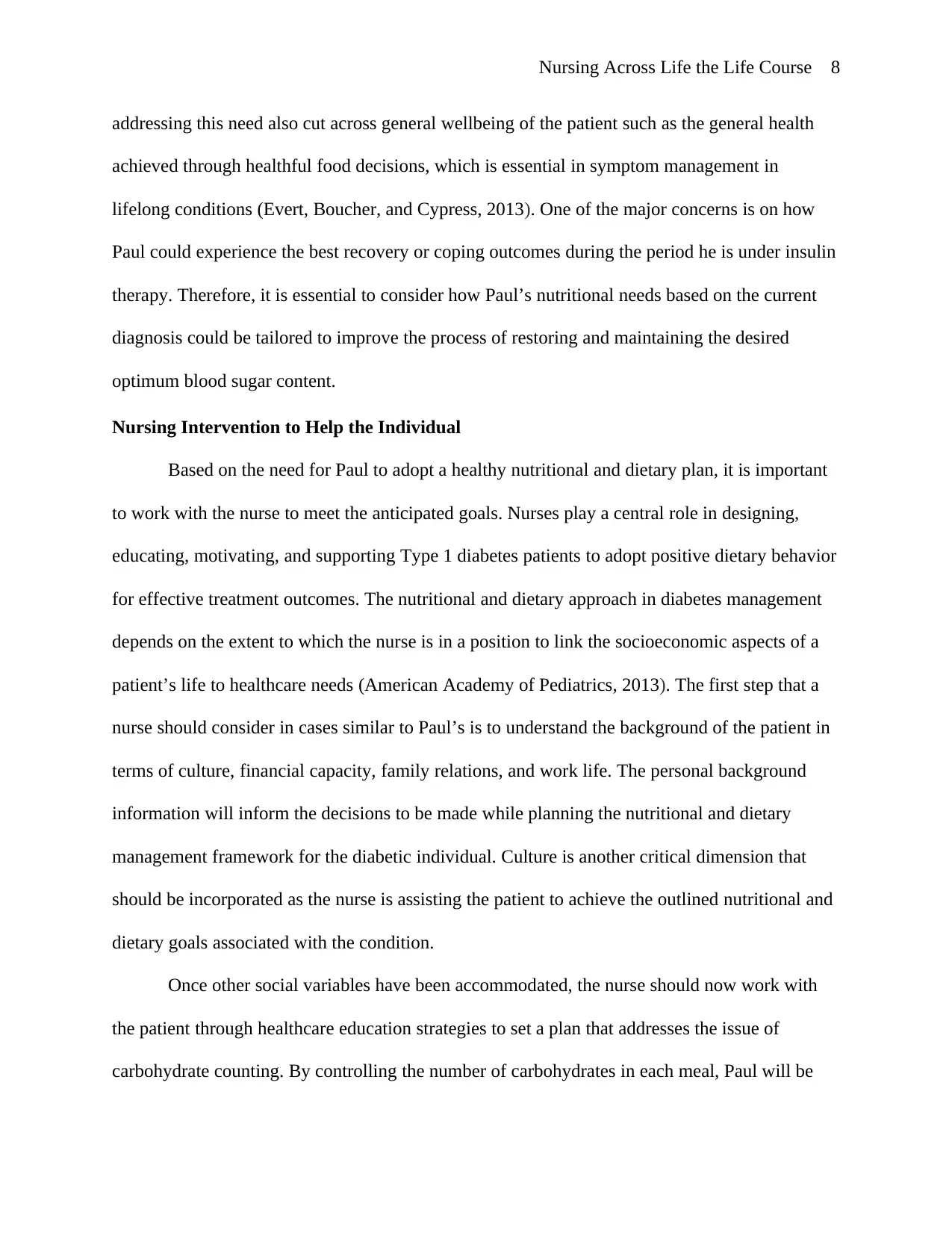
Nursing Across Life the Life Course 8
addressing this need also cut across general wellbeing of the patient such as the general health
achieved through healthful food decisions, which is essential in symptom management in
lifelong conditions (Evert, Boucher, and Cypress, 2013). One of the major concerns is on how
Paul could experience the best recovery or coping outcomes during the period he is under insulin
therapy. Therefore, it is essential to consider how Paul’s nutritional needs based on the current
diagnosis could be tailored to improve the process of restoring and maintaining the desired
optimum blood sugar content.
Nursing Intervention to Help the Individual
Based on the need for Paul to adopt a healthy nutritional and dietary plan, it is important
to work with the nurse to meet the anticipated goals. Nurses play a central role in designing,
educating, motivating, and supporting Type 1 diabetes patients to adopt positive dietary behavior
for effective treatment outcomes. The nutritional and dietary approach in diabetes management
depends on the extent to which the nurse is in a position to link the socioeconomic aspects of a
patient’s life to healthcare needs (American Academy of Pediatrics, 2013). The first step that a
nurse should consider in cases similar to Paul’s is to understand the background of the patient in
terms of culture, financial capacity, family relations, and work life. The personal background
information will inform the decisions to be made while planning the nutritional and dietary
management framework for the diabetic individual. Culture is another critical dimension that
should be incorporated as the nurse is assisting the patient to achieve the outlined nutritional and
dietary goals associated with the condition.
Once other social variables have been accommodated, the nurse should now work with
the patient through healthcare education strategies to set a plan that addresses the issue of
carbohydrate counting. By controlling the number of carbohydrates in each meal, Paul will be
addressing this need also cut across general wellbeing of the patient such as the general health
achieved through healthful food decisions, which is essential in symptom management in
lifelong conditions (Evert, Boucher, and Cypress, 2013). One of the major concerns is on how
Paul could experience the best recovery or coping outcomes during the period he is under insulin
therapy. Therefore, it is essential to consider how Paul’s nutritional needs based on the current
diagnosis could be tailored to improve the process of restoring and maintaining the desired
optimum blood sugar content.
Nursing Intervention to Help the Individual
Based on the need for Paul to adopt a healthy nutritional and dietary plan, it is important
to work with the nurse to meet the anticipated goals. Nurses play a central role in designing,
educating, motivating, and supporting Type 1 diabetes patients to adopt positive dietary behavior
for effective treatment outcomes. The nutritional and dietary approach in diabetes management
depends on the extent to which the nurse is in a position to link the socioeconomic aspects of a
patient’s life to healthcare needs (American Academy of Pediatrics, 2013). The first step that a
nurse should consider in cases similar to Paul’s is to understand the background of the patient in
terms of culture, financial capacity, family relations, and work life. The personal background
information will inform the decisions to be made while planning the nutritional and dietary
management framework for the diabetic individual. Culture is another critical dimension that
should be incorporated as the nurse is assisting the patient to achieve the outlined nutritional and
dietary goals associated with the condition.
Once other social variables have been accommodated, the nurse should now work with
the patient through healthcare education strategies to set a plan that addresses the issue of
carbohydrate counting. By controlling the number of carbohydrates in each meal, Paul will be
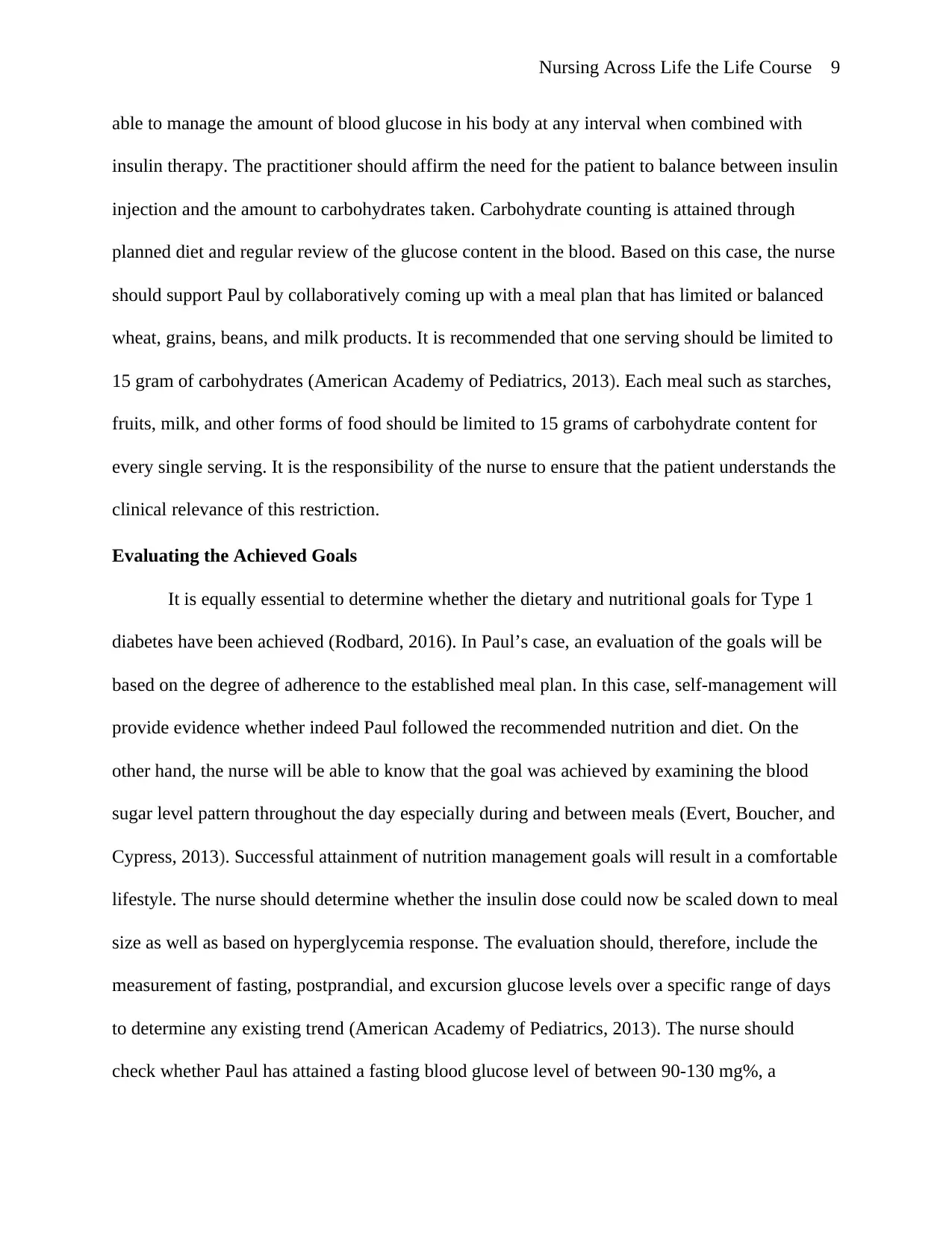
Nursing Across Life the Life Course 9
able to manage the amount of blood glucose in his body at any interval when combined with
insulin therapy. The practitioner should affirm the need for the patient to balance between insulin
injection and the amount to carbohydrates taken. Carbohydrate counting is attained through
planned diet and regular review of the glucose content in the blood. Based on this case, the nurse
should support Paul by collaboratively coming up with a meal plan that has limited or balanced
wheat, grains, beans, and milk products. It is recommended that one serving should be limited to
15 gram of carbohydrates (American Academy of Pediatrics, 2013). Each meal such as starches,
fruits, milk, and other forms of food should be limited to 15 grams of carbohydrate content for
every single serving. It is the responsibility of the nurse to ensure that the patient understands the
clinical relevance of this restriction.
Evaluating the Achieved Goals
It is equally essential to determine whether the dietary and nutritional goals for Type 1
diabetes have been achieved (Rodbard, 2016). In Paul’s case, an evaluation of the goals will be
based on the degree of adherence to the established meal plan. In this case, self-management will
provide evidence whether indeed Paul followed the recommended nutrition and diet. On the
other hand, the nurse will be able to know that the goal was achieved by examining the blood
sugar level pattern throughout the day especially during and between meals (Evert, Boucher, and
Cypress, 2013). Successful attainment of nutrition management goals will result in a comfortable
lifestyle. The nurse should determine whether the insulin dose could now be scaled down to meal
size as well as based on hyperglycemia response. The evaluation should, therefore, include the
measurement of fasting, postprandial, and excursion glucose levels over a specific range of days
to determine any existing trend (American Academy of Pediatrics, 2013). The nurse should
check whether Paul has attained a fasting blood glucose level of between 90-130 mg%, a
able to manage the amount of blood glucose in his body at any interval when combined with
insulin therapy. The practitioner should affirm the need for the patient to balance between insulin
injection and the amount to carbohydrates taken. Carbohydrate counting is attained through
planned diet and regular review of the glucose content in the blood. Based on this case, the nurse
should support Paul by collaboratively coming up with a meal plan that has limited or balanced
wheat, grains, beans, and milk products. It is recommended that one serving should be limited to
15 gram of carbohydrates (American Academy of Pediatrics, 2013). Each meal such as starches,
fruits, milk, and other forms of food should be limited to 15 grams of carbohydrate content for
every single serving. It is the responsibility of the nurse to ensure that the patient understands the
clinical relevance of this restriction.
Evaluating the Achieved Goals
It is equally essential to determine whether the dietary and nutritional goals for Type 1
diabetes have been achieved (Rodbard, 2016). In Paul’s case, an evaluation of the goals will be
based on the degree of adherence to the established meal plan. In this case, self-management will
provide evidence whether indeed Paul followed the recommended nutrition and diet. On the
other hand, the nurse will be able to know that the goal was achieved by examining the blood
sugar level pattern throughout the day especially during and between meals (Evert, Boucher, and
Cypress, 2013). Successful attainment of nutrition management goals will result in a comfortable
lifestyle. The nurse should determine whether the insulin dose could now be scaled down to meal
size as well as based on hyperglycemia response. The evaluation should, therefore, include the
measurement of fasting, postprandial, and excursion glucose levels over a specific range of days
to determine any existing trend (American Academy of Pediatrics, 2013). The nurse should
check whether Paul has attained a fasting blood glucose level of between 90-130 mg%, a
⊘ This is a preview!⊘
Do you want full access?
Subscribe today to unlock all pages.

Trusted by 1+ million students worldwide
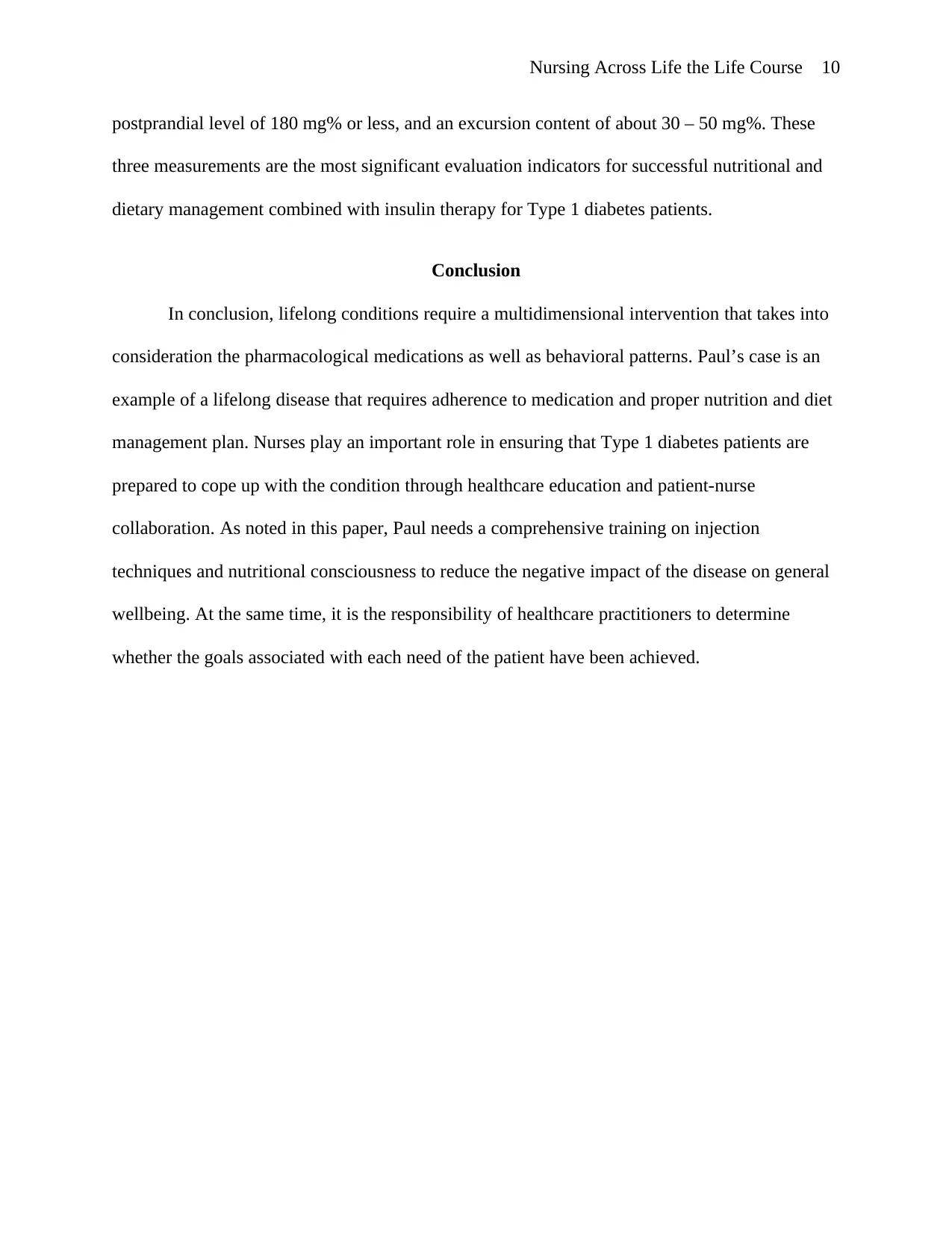
Nursing Across Life the Life Course 10
postprandial level of 180 mg% or less, and an excursion content of about 30 – 50 mg%. These
three measurements are the most significant evaluation indicators for successful nutritional and
dietary management combined with insulin therapy for Type 1 diabetes patients.
Conclusion
In conclusion, lifelong conditions require a multidimensional intervention that takes into
consideration the pharmacological medications as well as behavioral patterns. Paul’s case is an
example of a lifelong disease that requires adherence to medication and proper nutrition and diet
management plan. Nurses play an important role in ensuring that Type 1 diabetes patients are
prepared to cope up with the condition through healthcare education and patient-nurse
collaboration. As noted in this paper, Paul needs a comprehensive training on injection
techniques and nutritional consciousness to reduce the negative impact of the disease on general
wellbeing. At the same time, it is the responsibility of healthcare practitioners to determine
whether the goals associated with each need of the patient have been achieved.
postprandial level of 180 mg% or less, and an excursion content of about 30 – 50 mg%. These
three measurements are the most significant evaluation indicators for successful nutritional and
dietary management combined with insulin therapy for Type 1 diabetes patients.
Conclusion
In conclusion, lifelong conditions require a multidimensional intervention that takes into
consideration the pharmacological medications as well as behavioral patterns. Paul’s case is an
example of a lifelong disease that requires adherence to medication and proper nutrition and diet
management plan. Nurses play an important role in ensuring that Type 1 diabetes patients are
prepared to cope up with the condition through healthcare education and patient-nurse
collaboration. As noted in this paper, Paul needs a comprehensive training on injection
techniques and nutritional consciousness to reduce the negative impact of the disease on general
wellbeing. At the same time, it is the responsibility of healthcare practitioners to determine
whether the goals associated with each need of the patient have been achieved.
Paraphrase This Document
Need a fresh take? Get an instant paraphrase of this document with our AI Paraphraser
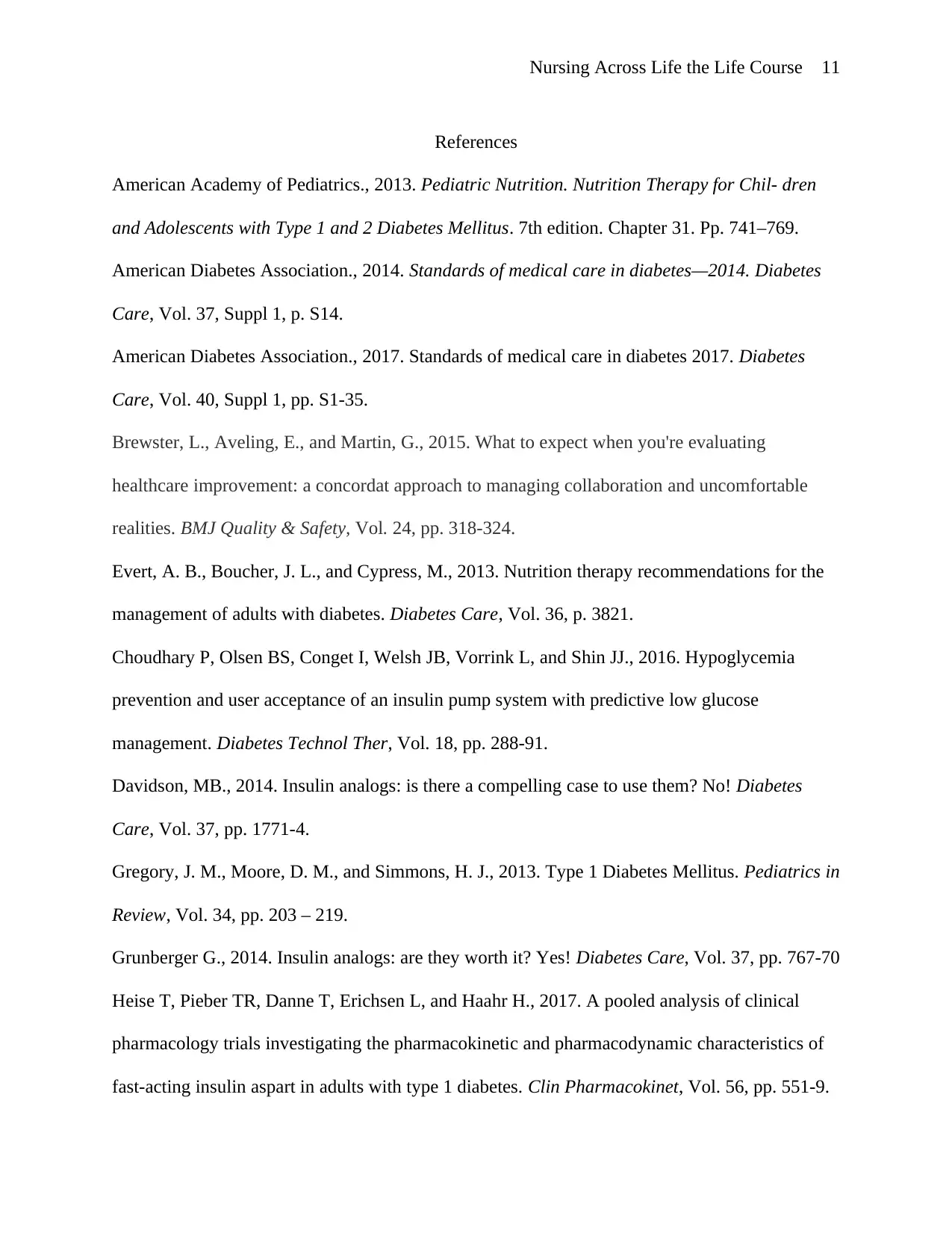
Nursing Across Life the Life Course 11
References
American Academy of Pediatrics., 2013. Pediatric Nutrition. Nutrition Therapy for Chil‐ dren
and Adolescents with Type 1 and 2 Diabetes Mellitus. 7th edition. Chapter 31. Pp. 741–769.
American Diabetes Association., 2014. Standards of medical care in diabetes—2014. Diabetes
Care, Vol. 37, Suppl 1, p. S14.
American Diabetes Association., 2017. Standards of medical care in diabetes 2017. Diabetes
Care, Vol. 40, Suppl 1, pp. S1-35.
Brewster, L., Aveling, E., and Martin, G., 2015. What to expect when you're evaluating
healthcare improvement: a concordat approach to managing collaboration and uncomfortable
realities. BMJ Quality & Safety, Vol. 24, pp. 318-324.
Evert, A. B., Boucher, J. L., and Cypress, M., 2013. Nutrition therapy recommendations for the
management of adults with diabetes. Diabetes Care, Vol. 36, p. 3821.
Choudhary P, Olsen BS, Conget I, Welsh JB, Vorrink L, and Shin JJ., 2016. Hypoglycemia
prevention and user acceptance of an insulin pump system with predictive low glucose
management. Diabetes Technol Ther, Vol. 18, pp. 288-91.
Davidson, MB., 2014. Insulin analogs: is there a compelling case to use them? No! Diabetes
Care, Vol. 37, pp. 1771-4.
Gregory, J. M., Moore, D. M., and Simmons, H. J., 2013. Type 1 Diabetes Mellitus. Pediatrics in
Review, Vol. 34, pp. 203 – 219.
Grunberger G., 2014. Insulin analogs: are they worth it? Yes! Diabetes Care, Vol. 37, pp. 767-70
Heise T, Pieber TR, Danne T, Erichsen L, and Haahr H., 2017. A pooled analysis of clinical
pharmacology trials investigating the pharmacokinetic and pharmacodynamic characteristics of
fast-acting insulin aspart in adults with type 1 diabetes. Clin Pharmacokinet, Vol. 56, pp. 551-9.
References
American Academy of Pediatrics., 2013. Pediatric Nutrition. Nutrition Therapy for Chil‐ dren
and Adolescents with Type 1 and 2 Diabetes Mellitus. 7th edition. Chapter 31. Pp. 741–769.
American Diabetes Association., 2014. Standards of medical care in diabetes—2014. Diabetes
Care, Vol. 37, Suppl 1, p. S14.
American Diabetes Association., 2017. Standards of medical care in diabetes 2017. Diabetes
Care, Vol. 40, Suppl 1, pp. S1-35.
Brewster, L., Aveling, E., and Martin, G., 2015. What to expect when you're evaluating
healthcare improvement: a concordat approach to managing collaboration and uncomfortable
realities. BMJ Quality & Safety, Vol. 24, pp. 318-324.
Evert, A. B., Boucher, J. L., and Cypress, M., 2013. Nutrition therapy recommendations for the
management of adults with diabetes. Diabetes Care, Vol. 36, p. 3821.
Choudhary P, Olsen BS, Conget I, Welsh JB, Vorrink L, and Shin JJ., 2016. Hypoglycemia
prevention and user acceptance of an insulin pump system with predictive low glucose
management. Diabetes Technol Ther, Vol. 18, pp. 288-91.
Davidson, MB., 2014. Insulin analogs: is there a compelling case to use them? No! Diabetes
Care, Vol. 37, pp. 1771-4.
Gregory, J. M., Moore, D. M., and Simmons, H. J., 2013. Type 1 Diabetes Mellitus. Pediatrics in
Review, Vol. 34, pp. 203 – 219.
Grunberger G., 2014. Insulin analogs: are they worth it? Yes! Diabetes Care, Vol. 37, pp. 767-70
Heise T, Pieber TR, Danne T, Erichsen L, and Haahr H., 2017. A pooled analysis of clinical
pharmacology trials investigating the pharmacokinetic and pharmacodynamic characteristics of
fast-acting insulin aspart in adults with type 1 diabetes. Clin Pharmacokinet, Vol. 56, pp. 551-9.
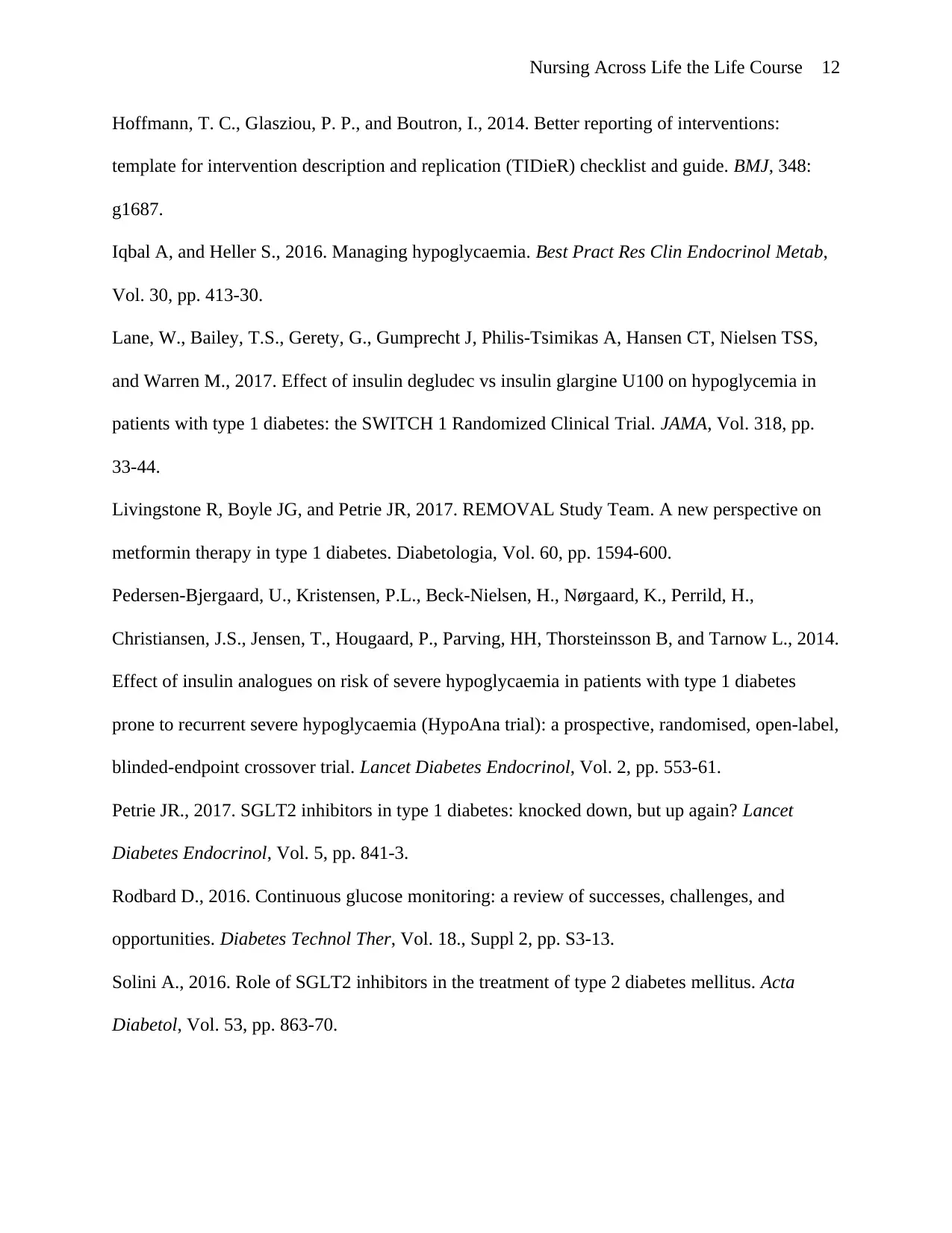
Nursing Across Life the Life Course 12
Hoffmann, T. C., Glasziou, P. P., and Boutron, I., 2014. Better reporting of interventions:
template for intervention description and replication (TIDieR) checklist and guide. BMJ, 348:
g1687.
Iqbal A, and Heller S., 2016. Managing hypoglycaemia. Best Pract Res Clin Endocrinol Metab,
Vol. 30, pp. 413-30.
Lane, W., Bailey, T.S., Gerety, G., Gumprecht J, Philis-Tsimikas A, Hansen CT, Nielsen TSS,
and Warren M., 2017. Effect of insulin degludec vs insulin glargine U100 on hypoglycemia in
patients with type 1 diabetes: the SWITCH 1 Randomized Clinical Trial. JAMA, Vol. 318, pp.
33-44.
Livingstone R, Boyle JG, and Petrie JR, 2017. REMOVAL Study Team. A new perspective on
metformin therapy in type 1 diabetes. Diabetologia, Vol. 60, pp. 1594-600.
Pedersen-Bjergaard, U., Kristensen, P.L., Beck-Nielsen, H., Nørgaard, K., Perrild, H.,
Christiansen, J.S., Jensen, T., Hougaard, P., Parving, HH, Thorsteinsson B, and Tarnow L., 2014.
Effect of insulin analogues on risk of severe hypoglycaemia in patients with type 1 diabetes
prone to recurrent severe hypoglycaemia (HypoAna trial): a prospective, randomised, open-label,
blinded-endpoint crossover trial. Lancet Diabetes Endocrinol, Vol. 2, pp. 553-61.
Petrie JR., 2017. SGLT2 inhibitors in type 1 diabetes: knocked down, but up again? Lancet
Diabetes Endocrinol, Vol. 5, pp. 841-3.
Rodbard D., 2016. Continuous glucose monitoring: a review of successes, challenges, and
opportunities. Diabetes Technol Ther, Vol. 18., Suppl 2, pp. S3-13.
Solini A., 2016. Role of SGLT2 inhibitors in the treatment of type 2 diabetes mellitus. Acta
Diabetol, Vol. 53, pp. 863-70.
Hoffmann, T. C., Glasziou, P. P., and Boutron, I., 2014. Better reporting of interventions:
template for intervention description and replication (TIDieR) checklist and guide. BMJ, 348:
g1687.
Iqbal A, and Heller S., 2016. Managing hypoglycaemia. Best Pract Res Clin Endocrinol Metab,
Vol. 30, pp. 413-30.
Lane, W., Bailey, T.S., Gerety, G., Gumprecht J, Philis-Tsimikas A, Hansen CT, Nielsen TSS,
and Warren M., 2017. Effect of insulin degludec vs insulin glargine U100 on hypoglycemia in
patients with type 1 diabetes: the SWITCH 1 Randomized Clinical Trial. JAMA, Vol. 318, pp.
33-44.
Livingstone R, Boyle JG, and Petrie JR, 2017. REMOVAL Study Team. A new perspective on
metformin therapy in type 1 diabetes. Diabetologia, Vol. 60, pp. 1594-600.
Pedersen-Bjergaard, U., Kristensen, P.L., Beck-Nielsen, H., Nørgaard, K., Perrild, H.,
Christiansen, J.S., Jensen, T., Hougaard, P., Parving, HH, Thorsteinsson B, and Tarnow L., 2014.
Effect of insulin analogues on risk of severe hypoglycaemia in patients with type 1 diabetes
prone to recurrent severe hypoglycaemia (HypoAna trial): a prospective, randomised, open-label,
blinded-endpoint crossover trial. Lancet Diabetes Endocrinol, Vol. 2, pp. 553-61.
Petrie JR., 2017. SGLT2 inhibitors in type 1 diabetes: knocked down, but up again? Lancet
Diabetes Endocrinol, Vol. 5, pp. 841-3.
Rodbard D., 2016. Continuous glucose monitoring: a review of successes, challenges, and
opportunities. Diabetes Technol Ther, Vol. 18., Suppl 2, pp. S3-13.
Solini A., 2016. Role of SGLT2 inhibitors in the treatment of type 2 diabetes mellitus. Acta
Diabetol, Vol. 53, pp. 863-70.
⊘ This is a preview!⊘
Do you want full access?
Subscribe today to unlock all pages.

Trusted by 1+ million students worldwide
1 out of 13
Related Documents
Your All-in-One AI-Powered Toolkit for Academic Success.
+13062052269
info@desklib.com
Available 24*7 on WhatsApp / Email
![[object Object]](/_next/static/media/star-bottom.7253800d.svg)
Unlock your academic potential
Copyright © 2020–2025 A2Z Services. All Rights Reserved. Developed and managed by ZUCOL.





